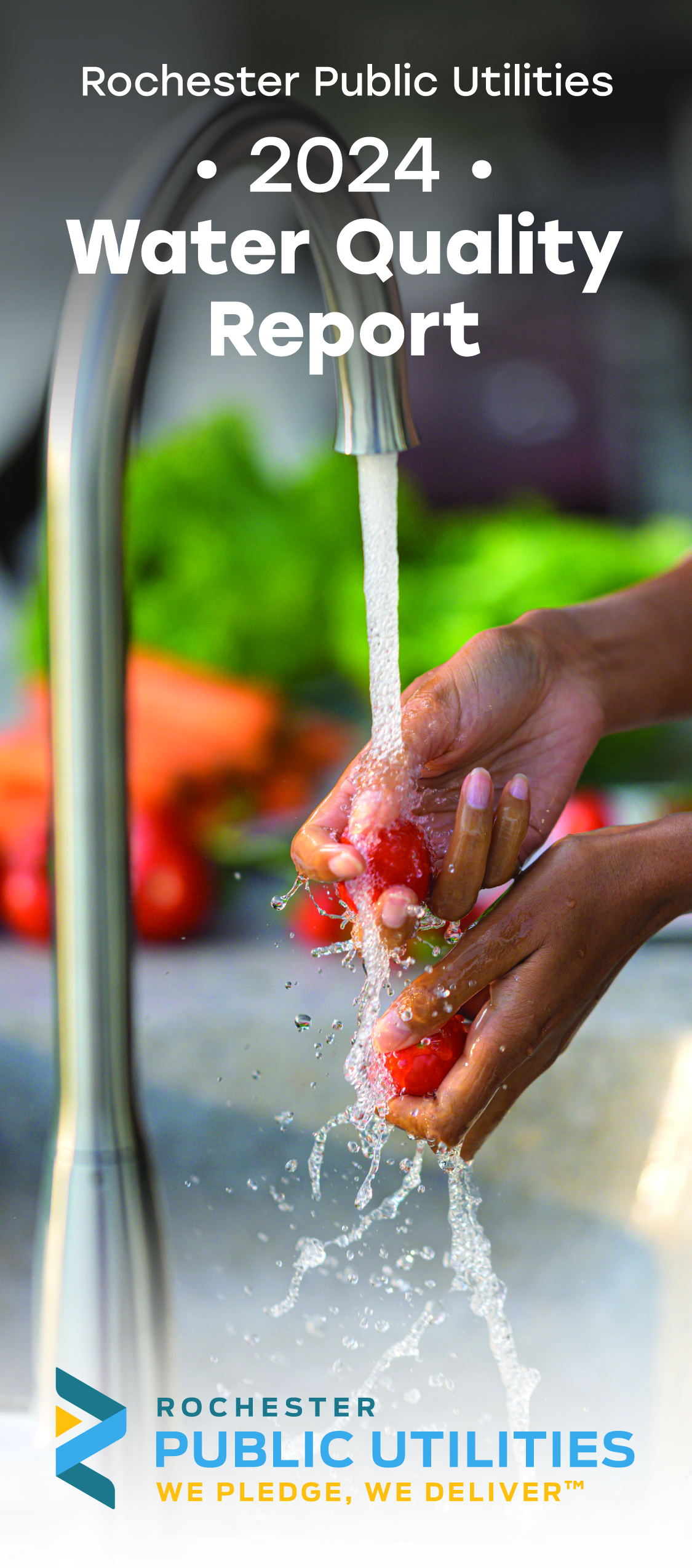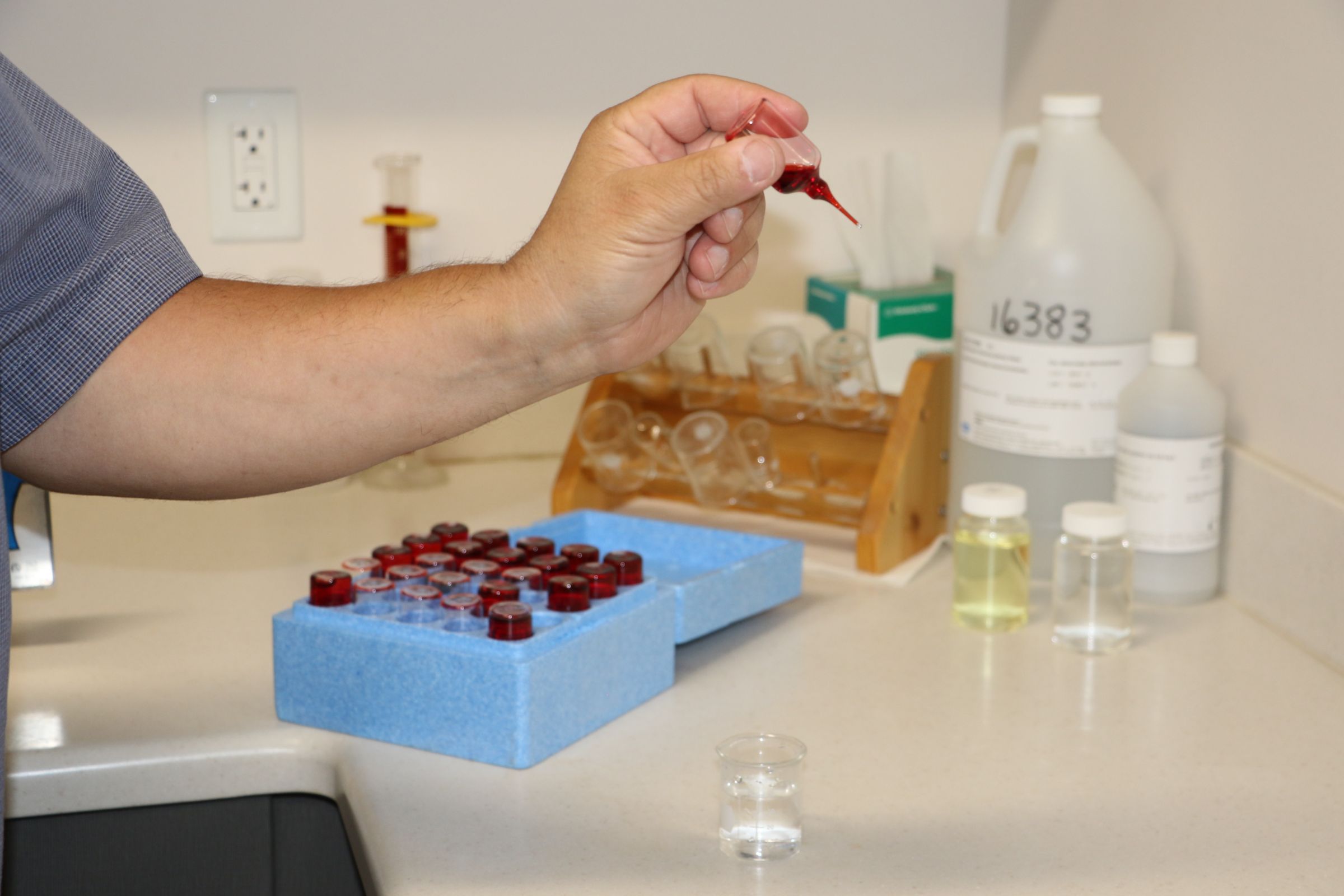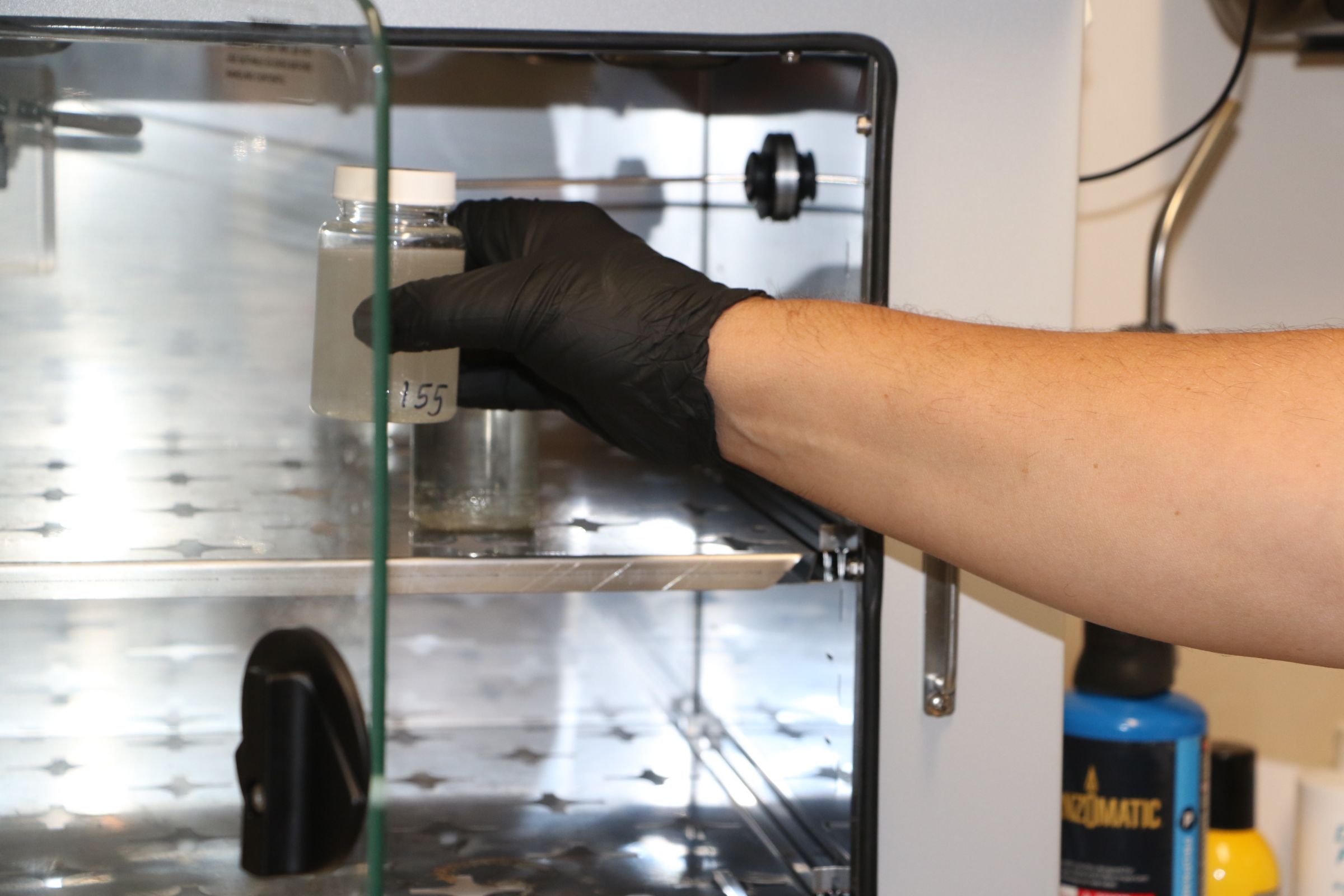Quick Links
RPU is dedicated to ensuring the safety of our community's drinking water. Regular testing, monitoring, and reporting are done to closely monitor the quality of our drinking water.
Water Source
Water is pumped from 31 deep groundwater wells located throughout the city. Most wells are 24 inches in diameter and extend 400-1,000 feet in depth. Water in the Rochester municipal system is drawn from water-bearing rock layers called aquifers. An aquifer is any type of geologic material, such as sand or sandstone, which can supply water to wells or springs. Most of Rochester’s water is drawn from the Jordan Aquifer, a deep sedimentary unit that underlies much of southeastern Minnesota. Water is also drawn from several multi-formation wells including: Prairie du Chien-Jordan, Prairie du Chien-Wonewoc, Jordan-Wonewoc, and Prairie du Chien-Mt. Simon aquifers.
Most wells are 24 inches in diameter and extend 400 to 900 feet in depth into the Prairie-du- Chien/Jordan geologic formation. Water is pumped directly from the wells into the distribution system. Chlorine (for bacteria control), hydrofluosilicic acid (fluoride for the prevention of dental caries), and a liquid blended polyphosphate (for protection from corrosion and stabilization of iron naturally present in our water supply) are added at each of the well house sites.
Testing and Reporting
Rochester Public Utilities checks and monitors each well on a daily basis. Pumpage from each well is tracked and logged, as well as chemical treatment levels. Water samples are tested in accordance with Minnesota Department of Health (MDH) regulations and requirements to ensure compliance with all drinking water regulations in the Safe Drinking Water Act (SDWA).
Water Treatment
Disinfection - Chlorine is used to disinfect our water and minimize the risk of microbial contamination by bacteria or viruses. The average total residual chlorine concentration in the system is maintained at 0.8 parts per million (ppm) (also stated as milligrams per liter, mg/L). RPU performs over 1,000 chlorine tests throughout the year to ensure the total residual chlorine is in check. Chlorine is added to drinking water systems to assure that microbial organisms such as bacteria and viruses cannot survive in the water. The chlorine levels are not a health concern and, in fact, are established to prevent health risk from bacteria and viruses. The Maximum Residual Disinfectant Level (MRDL) and the Maximum Residual Disinfectant Level Goal (MRDLG) for Chlorine is 4 ppm.
Fluoridation - Minnesota Statute 144.145 requires the fluoridation of water in all municipal water supplies except where natural levels are sufficient. A small amount of fluoride is added to our water to meet the MN State Statute requirement and also to improve dental health & reduce tooth decay. The average fluoride level in our water is currently being set at 0.7 milligrams per liter, based on recommendation of the U.S. Department of Health and Human Services. The Centers for Disease Control and Prevention (CDC) has recognized water fluoridation as one of ten great public health achievements of the 20th century. RPU performs more than 3,000 fluoride tests throughout the year to ensure our fluoride levels are 0.7 ppm.
Corrosion Control – A blended polyphosphate solution is used for corrosion control, by coating the water distribution system and household piping to prevent the leaching of lead and copper into the drinking water. The blended polyphosphate is also used to prevent rusty water. A concentration of approximately 0.5 ppm is maintained in the water distribution system.
Lead and Copper
To learn about RPU's Lead Service Line Replacement Program, click here.
Statewide Lead Inventory Tracking Tool (LITT): https://maps.umn.edu/LSL.
How to check your service line material: https://www.epa.gov/ground-water-and-drinking-water/protect-your-tap-quick-check-lead.
Lead and copper are inorganic compounds that differ from other contaminants in that they are rarely found in source waters. Usually, these contaminants enter the water through the corrosion of materials in the distribution system, including household plumbing.
Lead has been associated with impaired physical and mental development, hearing problems, and damage to the brain, nervous system, red blood cells, and kidneys.
Copper is an essential element for living organisms, including humans, and—in small amounts—necessary in our diet to ensure good health. However, too much copper can cause adverse health effects, including vomiting, diarrhea, stomach cramps, and nausea. It has also been associated with liver damage and kidney disease. The human body has a natural mechanism for maintaining the proper level of copper in it. However, children under one year old have not yet developed this mechanism and, as a result, are more vulnerable to the toxic effects of copper. People with Wilson's disease also have a problem with maintaining the proper balance and should also exercise particular care in limiting exposure to copper.
RPU has never exceeded the Lead and Copper testing program since it was initiated in 1990 under EPA’s Safe Drinking Water Act (SDWA). Corrective actions, such as corrosion control and public education, are required if an “action level” for each contaminant is exceeded in more than 10 percent of the samples collected from household taps. The action level for lead is 15 parts per billion (ppb), and the action level for copper is 1,300 parts per billion.
Lead and Copper testing is performed every three years. The testing is confirming that the optimized corrosion control program is effective. Below is a table that displays RPU’s compliance under the EPA’s SDWA Lead & Copper Testing program:
| 2016 | 2019 | 2022 | |
| Lead (ppb)4 | 4 | 6 | 3 |
| Copper (ppb)952 | 952 | 939 | 927 |
Below are links on additional information on Lead in Drinking Water from EPA and MDH. Southeastern Minnesota Water Analysis Laboratory (SEMWAL) in Rochester is a certified lab for lead testing.
- EPA Basic Information about Lead in Drinking Water
- EPA Lead Fact Sheet
- MDH Lead in Drinking Water
- MDH Let it run … and get the lead out!
- RPU's Lead in Drinking Water Brochure
Hardness
The sub-rock beneath Rochester Public Utilities soil is primarily limestone. This is a contributing factor to the “very hard” water of our ground water supply. RPU’s water contains 17 grains of hardness per gallon (gpg) or 280 parts per million (ppm). There are no harmful health effects associated with these minerals (in fact, some believe they are beneficial), but measuring them does provide a guideline as to how water use may be affected. For example, hard water does result in more scale buildup and you need to use more soap and detergents. If you choose a water softener, it's recommended that a separate, unsoftened supply of water be kept for cooking and drinking. Ion exchange water softeners remove hardness by replacing the calcium and magnesium with sodium salt.
Also, when you buy a new appliance, such as a dishwasher, the manufacturer often makes reference to water hardness. This is because hard water can cause automatic dishwashers to leave film on dishes and build-up of minerals on mechanical parts. It may also cause washing machines to leave residue on articles of clothing and scales that clog water pipes or foul appliances such as water heaters.
PFAS
Per- and polyfluoroalkl substances (PFAS), a large family of many fluorinated compounds, are used by several companies around the world in household and industrial products such as stain repellents, lubricants, fire retardant and suppressants, and more. PFAS wastes from a manufacturing site in Cottage Grove, Minn., were disposed of at various locations in Washington County. The source of PFAS in Woodbury’s groundwater has been identified as these disposal sites.
RPU has 32 wells that have been tested for PFAS. The testing has shown that RPU is compliant. RPU will continue to monitor and test for PFAS in drinking water. Thankfully, Rochester doesn’t have major contributors of PFAS, such as landfills, military bases, and airports. Click on this link to see all the PFAS testing results for RPU’s municipal wells tested by MN Dept. of Health. RPU PFAS Testing Results
Water Conservation
The water you use doesn’t appear magically. It is carefully pumped from our clean, safe, and reliable groundwater aquifers and piped directly into your home. Water is a valuable resource that shouldn’t be wasted. Besides, you’re paying for every drop whether it’s used or wasted! Water conservation is a good way of life – let’s practice it together! Click here to visit RPU’s Conservation page for some water conservations.
Groundwater Protection
Wellhead Protection Plan
As a result of amendments to the Safe Drinking Water Act in 1986, the federal government requires states to establish a wellhead protection plan. This program is designed to identify sources of supply for drinking water and any potential contaminants that might impact the water, providing a plan to protect the supply from contamination. The Minnesota Department of Health approved a plan requiring all communities and owners of water distribution systems in Minnesota to complete a wellhead protection plan. Rochester Public Utilities completed and received approval for the required Wellhead Protection Plan in 2007. The State of Minnesota Wellhead Protection Rules requires reviewing and amending the Wellhead Protection Plan every 10 years.
Rochester Public Utilities has been working with Barr Engineering to do the required Wellhead Protection Plan Amendment. The plan identifies all wells owned by RPU and used to provide the public water supply. Detailed information is included regarding which aquifer each well draws from, the surface area around the wells that could potentially introduce contaminants, and any source of contaminants that may be in that area. A section of the plan is an action list of activities that should be avoided in the wellhead areas or which might be initiated as a means of proactive protection.
Part one of the Wellhead Protection Plan Amendment was completed in the fall of 2017 and includes a delineation of the critical areas adjacent to our groundwater wells, and the potential vulnerability of each well.
Part two of the plan includes and inventory of potential contamination sources and actions RPU will take to address the potential contamination sources and protect the drinking water supply. Part two of the plan also includes strategies for enhancing public education regarding wellhead protection and RPU’s water supply. Part two was approved by MDH in May 2022.
Wellhead Protection Plan Amendment Documents
RPU Wellhead Protection Plan Part I (17.5MB)
RPU Wellhead Protection Plan Part II (13.5MB)
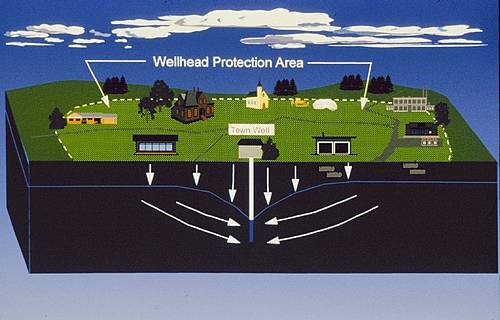
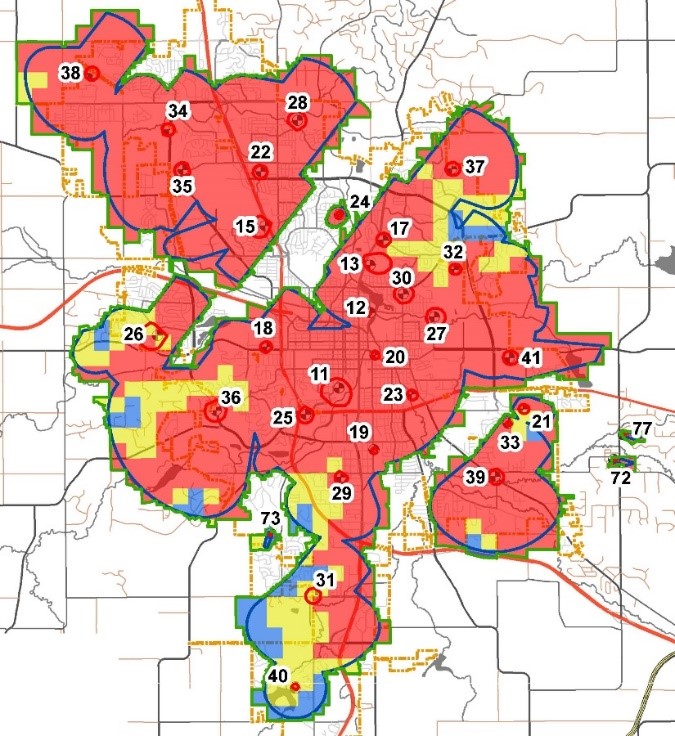
Well Sealing
Sealing older and unused wells helps protect the groundwater for future generations. An abandoned well can be a direct conduit for contaminants to reach drinking water aquifers. RPU water customers may be eligible for 50% reimbursement up to a max of $500. RPU water customers that live in a wellhead protection area may be eligible up to $1,000.
For more information on RPU’s Well Sealing Program please contact Todd Osweiler at tosweiler@rpu.org.

